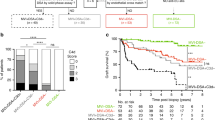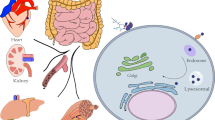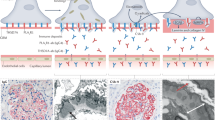Abstract
Graft rejection has long been considered the paradigm of renal diseases induced by alloimmunization, particularly alloimmunization directed against HLA antigens. Accumulating evidence indicates that non-HLA immunity also has an important role in clinical transplantation. Targets of alloimmunization include antigens of tubular basement membrane, tubular epithelial cells and endothelial cells. They can be polymorphic allovariants (as shown in the rat) or 'hidden' antigens exposed when the graft is damaged. Alloimmunization can also occur when a person genetically deficient in a renal protein (e.g. the α5 (IV) collagen chain in X-linked Alport's syndrome or nephrin in Finnish-type nephrotic syndrome) is transplanted to treat end-stage renal failure. The non-mutated protein in the donor kidney is recognized as a foreign antigen, and the resulting alloimmune response can damage the graft. We have demonstrated that alloimmunity can also affect the native kidney. We have characterized a novel fetomaternal disease in which a genetic defect in the MME gene encoding neutral endopeptidase (NEP) in the mother leads to the development of membranous nephropathy in her fetus (maternal anti-NEP antibodies bind to NEP on fetal podocytes). Our findings raise the possibility that mutations or genetic polyporphisms in MME or other genes expressed by the podocyte are involved in alloimmune-mediated development of membranous nephropathy after kidney or bone marrow transplantation.
Key Points
-
Alloimmunization—an immune response to antigens from a genetically distinct organism of the same species—can occur in transplanted, as well as native, kidneys
-
In grafted kidneys, alloimmunization can occur in response to donor HLA and non-HLA antigens (e.g. of tubular and glomerular basement membranes)
-
Alloimmunization causing nephropathy of native kidneys can occur in response to transplantation of bone marrow or stem cells, and microchimerism (arising from cell exchange between mother and fetus)
-
The authors have described a new form of alloimmunity in native kidneys—transplacental transfer of antibodies against podocyte-localized neutral endopeptidase from a mother, in whom the gene encoding neutral endopeptidase is mutated, to her fetus, resulting in nephrotic syndrome
This is a preview of subscription content, access via your institution
Access options
Subscribe to this journal
Receive 12 print issues and online access
$209.00 per year
only $17.42 per issue
Buy this article
- Purchase on Springer Link
- Instant access to full article PDF
Prices may be subject to local taxes which are calculated during checkout



Similar content being viewed by others
References
Dausset J (1971) The genetics of the HL-A system and its implications in transplantation. Vox Sang 20: 97–108
Dausset J (1966) Leucocyte and tissue groups. Vox Sang 11: 263–75
Aluvihare VR et al. (2004) Regulatory T cells mediate maternal tolerance to the fetus. Nat Immunol 5: 266–271
Mellor AL et al. (2001) Prevention of T cell-driven complement activation and inflammation by tryptophan catabolism during pregnancy. Nat Immunol 2: 64–68
Salmon JE (2004) A noninflammatory pathway for pregnancy loss: innate immune activation? J Clin Invest 114: 15–17
Xu C et al. (2000) A critical role for murine complement regulator Crry in fetomaternal tolerance. Science 287: 498–501
Varla-Leftherioti M (2004) Role of a KIR/HLA-C allorecognition system in pregnancy. J Reprod Immunol 62: 19–27
Bowman JM (1994) Hemolytic disease of the newborn. In Immunobiology of Transfusion Medicine, 553–584 (Ed. Garratty G) New York: Dekker
Peters B et al. (2004) Effect of heterosexual intercourse on mucosal alloimmunisation and resistance to HIV-1 infection. Lancet 363: 518–524
Jennes W and Kestens L (2004) Unprotected sex and alloimmune activation. Lancet 363: 1474
Debiec H et al. (2002) Antenatal membranous glomerulonephritis due to anti-neutral endopeptidase antibodies. N Engl J Med 346: 2053–2060
Debiec H et al. (2004) Role of truncating mutations in MME gene in fetomaternal alloimmunisation and antenatal glomerulopathies. Lancet 364: 1252–1259
Bianchi DW et al. (1996) Male fetal progenitor cells persist in maternal blood for as long as 27 years postpartum Proc Natl Acad Sci USA 93: 705–708
Nelson JL et al. (1998) Microchimerism and HLA-compatible relationships of pregnancy in scleroderma. Lancet 351: 559–562
Collins ZV et al. (1973) A naturally occurring monospecific anti-HL-A8 isoantibody. Tissue Antigens 3: 358–363
Lepage V et al. (1976) A “natural” anti-HLA-A2 antibody reacting with homozygous cells. Tissue Antigens 8: 139–142
Tongio MM et al. (1985) Natural HLA antibodies. Tissue Antigens 26: 271–285
Suthanthiran M and Strom TB (2005) Transplant immunology. In Oxford Textbook of Clinical Nephrology, vol 3, 2049–2059 (Ed. Davison AM) Oxford: Oxford University Press
Halloran PF (2002) Call for revolution: a new approach to describing allograft deterioration. Am J Transplant 2: 195–200
Poggio ED et al. (2004) Alloreactivity in renal transplant recipients with and without chronic allograft nephropathy. J Am Soc Nephrol 15: 1952–1960
Dong VM et al. (1999) Transplantation tolerance: the concept and its applicability. Pediatr Transplant 3: 181–192
Li XC et al. (2001) T cell death and transplantation tolerance. Immunity 14: 407–416
Paul LC (1999) Chronic allograft nephropathy: an update. Kidney Int 56: 783–793
Lehman DH et al. (1974) Induction of antitubular basement membrane antibodies in rats by renal transplantation. Transplantation 17: 429–431
Mancilla-Jimenez R et al. (1977) Antitubular basement membrane antibodies in renal allograft rejection. Transplantation 24: 39–44
Clayman MD et al. (1985) Isolation and characterization of the nephritogenic antigen producing anti-tubular basement membrane disease. J Exp Med 161: 290–305
Clayman MD et al. (1986) Isolation of the target antigen of human anti-tubular basement membrane antibody-associated interstitial nephritis. J Clin Invest 77: 1143–1147
Butkowski RJ et al. (1990) Characterization of a tubular basement membrane component reactive with autoantibodies associated with tubulointerstitial nephritis. J Biol Chem 265: 21091–21098
Butkowski RJ et al. (1991) Distribution of tubulointerstitial nephritis antigen and evidence for multiple forms. Kidney Int 40: 838–846
Ivanyi B et al. (1998) Childhood membranous nephropathy, circulating antibodies to the 58-kD TIN antigen, and anti-tubular basement membrane nephritis: an 11-year follow-up. Am J Kidney Dis 32: 1068–1074
Thoenes GH et al. (1979) Transplantation-induced immune complex kidney disease in rats with unilateral manifestation in the allografted kidney. Lab Invest 41: 321–333
Joosten SA et al. (2002) Antibody response against perlecan and collagen types IV and VI in chronic renal allograft rejection in the rat. Am J Pathol 160: 1301–1310
Joosten SA et al. (2005) Antibodies against mesangial cells in a rat model of chronic renal allograft rejection. Nephrol Dial Transplant 20: 692–698
Joosten SA et al. (2005) Antibody response against the glomerular basement membrane protein agrin in patients with transplant glomerulopathy. Am J Transplant 5: 383–393
Racusen LC (2004) Antibody-mediated rejection in the kidney. Transplant Proc 36: 768–769
van der Woude FJ et al. (1995) Tissue antigens in tubulointerstitial and vascular rejection. Kidney Int 52 (Suppl): S11–S13
Le Bas-Bernardet S et al. (2003) Non-HLA-type endothelial cell reactive alloantibodies in pre-transplant sera of kidney recipients trigger apoptosis. Am J Transplant 3: 167–177
Opelz G ; Collaborative Transplant Study (2005) Non-HLA transplantation immunity revealed by lymphocytotoxic antibodies. Lancet 365: 1570–1576
Dragun D et al. (2005) Angiotensin II type 1-receptor activating antibodies in renal-allograft rejection. N Engl J Med 352: 558–569
Barker DF et al. (1990) Identification of mutations in the COL4A5 collagen gene in Alport syndrome. Science 248: 1224–1227
Lemmink HH et al. (1994) Mutations in the type IV collagen alpha 3 (COL4A3) gene in autosomal recessive Alport syndrome. Hum Mol Genet 3: 1269–1273
Mochizuki T et al. (1994) Identification of mutations in the α3(IV) and α4(IV) collagen genes in autosomal recessive Alport syndrome. Nat Genet 8: 77–81
Longo I et al. (2002) COL4A3/COL4A4 mutations: from familial hematuria to autosomal-dominant or recessive Alport syndrome. Kidney Int 61: 1947–1956
Kalluri R et al. (1997) Isoform switching of type IV collagen is developmentally arrested in X-linked Alport syndrome leading to increased susceptibility of renal basement membranes to endoproteolysis. J Clin Invest 99: 2470–2478
Kashtan CE (2005) The nongenetic diagnosis of thin basement membrane nephropathy. Semin Nephrol 25: 159–162
Hudson BG et al. (2003) Alport's syndrome, Goodpasture's syndrome, and type IV collagen. New Engl J Med 348: 2543–2556
Byrne MC et al. (2002) Renal transplant in patients with Alport's syndrome. Am J Kidney Dis 39: 769–775
Kalluri R et al. (2000) Identification of α3, α4, and α5 chains of type IV collagen as alloantigens for Alport posttransplant anti-glomerular basement membrane antibodies. Transplantation 69: 679–683
Kalluri R et al. (1996) The Goodpasture autoantigen: structural delineation of two immunologically privileged epitopes on α3(IV) chain of type IV collagen. J Biol Chem 271: 9062–9068
Borza DB et al. (2000) The goodpasture autoantigen: identification of multiple cryptic epitopes on the NC1 domain of the α3(IV) collagen chain. J Biol Chem 275: 6030–6037
Kestila M et al. (1998) Positionally cloned gene for a novel glomerular protein-nephrin is mutated in congenital nephrotic syndrome. Mol Cell 1: 575–582
Patrakka J et al. (2002) Recurrence of nephrotic syndrome in kidney grafts of patients with congenital nephrotic syndrome of the Finnish type: role of nephrin. Transplantation 73: 394–403
Orikasa M et al. (1988) Massive proteinuria induced in rats by a single intravenous injection of a monoclonal antibody. J Immunol 141: 807–814
Topham PS et al. (1999) Nephritogenic mAb 5-1-6 is directed at the extracellular domain of rat nephrin. J Clin Invest 104: 1559–1566
Billing H et al. (2004) NPHS2 mutation associated with recurrence of proteinuria after transplantation. Pediatr Nephrol 19: 561–564
Turner AJ et al. (2001) The neprilysin (NEP) family of zinc metalloendopeptidases: genomics and function. Bioessays 23: 261–269
Lu B et al. (1997) The control of microvascular permeability and blood pressure by neutral endopeptidase. Nat Med 3: 904–907
Ikeda K et al. (1999) Molecular identification and characterization of novel membrane-bound metalloprotease, the soluble secreted form of which hydrolyzes a variety of vasoactive peptides. J Biol Chem 274: 32469–32477
Bonvouloir N et al. (2001) Molecular cloning, tissue distribution, and chromosomal localization of MMEL2, a gene coding for a novel human member of the neutral endopeptidase-24.11 family. DNA Cell Biol 20: 493–498
Ronco P and Debiec H (2005) Molecular pathomechanisms of membranous nephropathy: from Heymann nephritis to alloimmunization. J Am Soc Nephrol 16: 1205–1213.
Riemersma S et al. (1996) Association of arthrogryposis multiplex congenita with maternal antibodies inhibiting fetal acetylcholine receptor function. J Clin Invest 98: 2358–2363
Whitington PF and Hibbard JU (2004) High-dose immunoglobulin during pregnancy for recurrent neonatal haemochromatosis. Lancet 364: 1690–1698
Whitington PF and Malladi P (2005) Neonatal hemochromatosis: is it an alloimmune disease? J Pediatr Gastroenterol Nutr 40: 544–549
Lin J et al. (2001) Membranous glomerulopathy associated with graft-versus-host disease following allogeneic stem cell transplantation: report of 2 cases and review of the literature. Am J Nephrol 21: 351–356
Rossi L et al. (2001) Membranous glomerulonephritis after haematopoietic cell transplantation for multiple myeloma. Nephron 88: 260–263
Miyazaki Y et al. (2003) Membranous nephropathy associated with donor lymphocyte infusion following allogeneic bone marrow transplantation. Int J Hematol 78: 262–265
Tsutsumi C et al. (2004) Membranous nephropathy after allogeneic stem cell transplantation: report of 2 cases. Int J Hematol 79: 193–197
Stevenson WS et al. (2005) Nephrotic syndrome after stem cell transplantation. Clin Transplant 19: 141–144
Ikee R et al. (2004) Recurrent nephrotic syndrome associated with graft-versus-host disease. Bone Marrow Transplant 34: 1005–1006
Bruijn JA et al. (1988) Murine chronic graft-versus-host disease as a model for lupus nephritis. Am J Pathol 130: 639–641
Maloney S et al. (1999) Microchimerism of maternal origin persists into adult life. J Clin Invest 104: 41–47
Adams KM and Nelson JL (2004) Microchimerism: an investigative frontier in autoimmunity and transplantation. JAMA 291: 1127–1131
Reed AM et al. (2000) Chimerism in children with juvenile dermatomyositis. Lancet 356: 2156–2157
Stevens AM et al. (2003) Myocardial-tissue-specific phenotype of maternal microchimerism in neonatal lupus congenital heart block. Lancet 362: 1617–1623
Khosrotehrani K and Bianchi DW (2003) Fetal cell microchimerism: helpful or harmful to the parous woman? Curr Opin Obstet Gynecol 15: 195–199
Lambert NC et al. (2005) Male microchimerism in women with systemic sclerosis and healthy women who have never given birth to a son. Ann Rheum Dis 64: 845–848
Lambert NC et al. (2002) Male microchimerism in healthy women and women with scleroderma: cells or circulating DNA? A quantitative answer. Blood 100: 2845–2851
Artlett CM et al. (2002) Increased microchimeric CD4+ T lymphocytes in peripheral blood from women with systemic sclerosis. Clin Immunol 103: 303–308
Srivatsa B et al. (2001) Microchimerism of presumed fetal origin in thyroid specimens from women: a case-control study. Lancet 358: 2034–2038
Artlett CM et al. (2002) Influence of prior pregnancies on disease course and cause of death in systemic sclerosis. Ann Rheum Dis 61: 346–350
Johnson KL et al. (2002) Significant fetal cell microchimerism in a nontransfused woman with hepatitis C: evidence of long-term survival and expansion. Hepatology 36: 1295–1297
Nagahama K et al. (2005) Possible role of autoantibodies against nephrin in an experimental model of chronic graft-versus-host disease. Clin Exp Immunol 141: 215–222
Acknowledgements
This work was supported by grants from INSERM, University Paris 6, GIS-Institute of Rare Diseases, Amgen France, and a gift from Mrs Halpin to the American branch of the Foundation of France. We are grateful to Christine Vial for assistance in preparing the manuscript.
Author information
Authors and Affiliations
Corresponding authors
Ethics declarations
Competing interests
The authors declare no competing financial interests.
Rights and permissions
About this article
Cite this article
Ronco, P., Debiec, H. & Guigonis, V. Mechanisms of Disease: alloimmunization in renal diseases. Nat Rev Nephrol 2, 388–397 (2006). https://doi.org/10.1038/ncpneph0198
Received:
Accepted:
Issue Date:
DOI: https://doi.org/10.1038/ncpneph0198
This article is cited by
-
Genetic homogeneity but IgG subclass–dependent clinical variability of alloimmune membranous nephropathy with anti-neutral endopeptidase antibodies
Kidney International (2015)
-
Immunopathogenesis of membranous nephropathy: an update
Seminars in Immunopathology (2014)
-
Fetomaternal alloimmunity as a cause of liver disease
Autoimmunity Highlights (2011)



